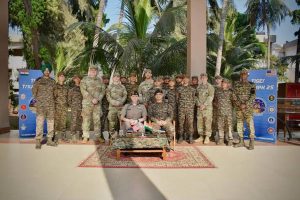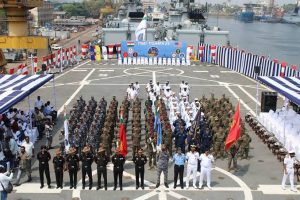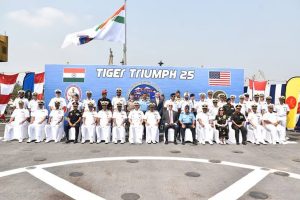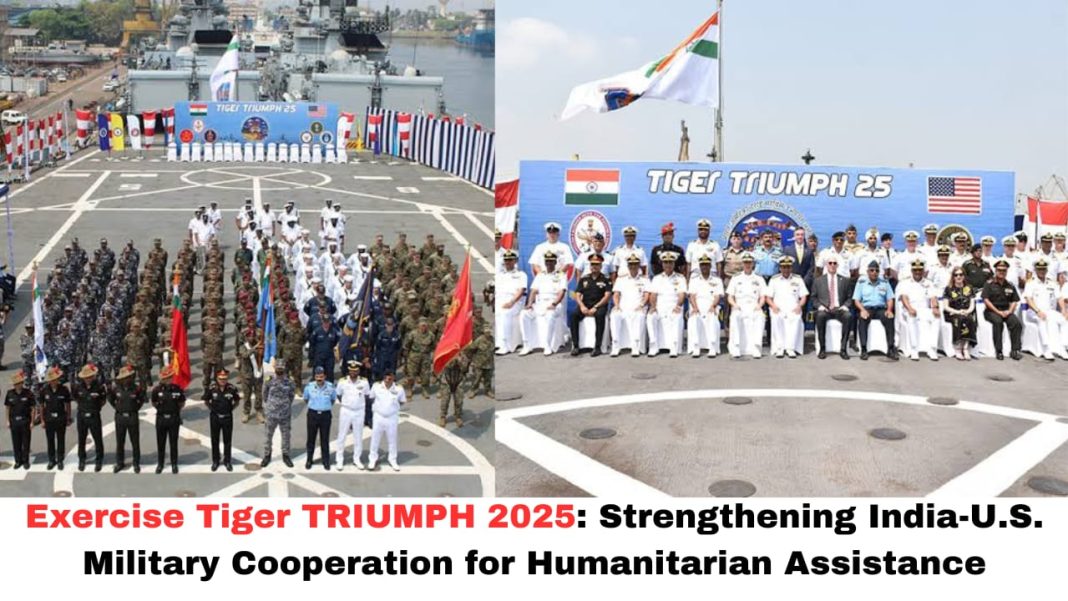Digital News Guru Current Affairs Desk:
The India-U.S. joint military exercise Tiger TRIUMPH 2025 commenced on April 1, 2025, in Visakhapatnam, India, marking a significant step toward strengthening bilateral defense cooperation between the two nations. This exercise, which primarily focuses on humanitarian assistance and disaster relief (HADR) operations, aims to enhance the interoperability of the armed forces of both countries in responding to humanitarian crises and natural disasters.
Tiger TRIUMPH 2025 is the fourth edition of this joint military exercise and underscores the growing strategic partnership between India and the United States. The exercise, which will be conducted in two phases—the harbor phase in Visakhapatnam (April 1-7) and the sea phase off the coast of Kakinada (April 8-13)—features joint planning, amphibious operations, medical aid simulations, and disaster relief drills.
Background of Exercise Tiger TRIUMPH
The Tiger TRIUMPH (Tri-Services India-U.S. Amphibious Exercise) series was launched in 2019 as a tri-service military exercise, meaning that it involves the participation of the Indian Army, Navy, and Air Force, along with their U.S. counterparts. The primary objective of this exercise is to improve operational coordination and joint response mechanisms in the event of natural disasters or humanitarian crises in the Indo-Pacific region.

The name “TRIUMPH” represents the joint capabilities of the two nations in conducting amphibious operations. Given the increasing instances of natural calamities in the region, such as cyclones, tsunamis, and earthquakes, both India and the United States recognize the importance of seamless cooperation in HADR operations.
Participating Forces and Equipment
The 2025 edition of the exercise features a wide range of assets from both nations, including warships, aircraft, helicopters, and troops.
Indian Armed Forces Participants:
- Indian Navy: INS Jalashwa, INS Gharial, INS Mumbai, and INS Shakti, along with integral helicopters and landing crafts.
- Indian Army: 91 Infantry Brigade and 12 Mechanized Infantry Battalion.
- Indian Air Force: C-130 aircraft, MI-17 helicopters, and Rapid Action Medical Team (RAMT).
United States Armed Forces Participants:
- U.S. Navy: USS Comstock (Landing Ship Dock) and USS Ralph Johnson (Arleigh Burke-class guided-missile destroyer), along with embarked U.S. Marines.
The involvement of a large number of personnel, ships, and aircraft from both countries demonstrates the serious commitment toward developing an efficient and coordinated disaster response mechanism.
Key Objectives and Activities
Tiger TRIUMPH 2025 aims to achieve several objectives related to disaster response, medical aid, and joint operations.
- Enhancing Joint Disaster Response Capabilities
One of the primary focuses of the exercise is to simulate disaster scenarios such as an earthquake or a cyclone, requiring immediate humanitarian relief efforts. The Indian Army and U.S. Marines will establish a joint command and control center at the Kakinada Naval Enclave, where military personnel will plan and coordinate disaster relief operations.
- Amphibious and Maritime Operations
The sea phase of the exercise, set to take place off the coast of Kakinada, will include a series of amphibious landing drills. The Indian and U.S. navies will practice:
- Deploying troops from ships to shore using landing crafts and helicopters.
- Transporting humanitarian aid supplies to disaster-stricken areas.
- Conducting joint patrolling and search-and-rescue operations.

- Joint Medical Camps and Humanitarian Aid
The Indian Air Force’s Rapid Action Medical Team (RAMT) and U.S. Navy medical teams will set up joint medical camps to provide healthcare services in simulated disaster-affected areas. These activities will involve:
- Emergency medical care for injured civilians.
- Mass casualty evacuation drills using military transport aircraft and helicopters.
- Coordination of logistical support for food, water, and medical supplies distribution.
- Integrated Training and Planning
During the harbor phase in Visakhapatnam, military personnel from both nations will engage in:
- Subject Matter Expert Exchanges (SMEEs) to discuss best practices in disaster relief and amphibious operations.
- Tabletop exercises to develop joint strategies for responding to real-world humanitarian crises.
- Cultural exchange programs to strengthen the bond between Indian and U.S. military personnel.
Strategic Importance of Tiger TRIUMPH 2025
- Strengthening India-U.S. Defense Relations
The Tiger TRIUMPH series reflects the growing military cooperation between India and the United States. The Indo-Pacific region is prone to natural disasters, and both nations recognize the need for seamless coordination in providing humanitarian assistance and disaster relief. This exercise builds on previous joint initiatives such as Malabar Naval Exercises and the Quadrilateral Security Dialogue (Quad) engagements.
- Indo-Pacific Security and Stability
The Indo-Pacific region is increasingly becoming a geopolitical focal point, with major powers vying for influence. The U.S. Indo-Pacific Strategy aligns with India’s vision for a free, open, and inclusive Indo-Pacific. By conducting joint military exercises like Tiger TRIUMPH, both nations send a strong message about their commitment to regional security and stability.
- Capacity Building for Disaster Response
With the rising frequency of natural disasters due to climate change, the need for a well-coordinated and rapid disaster response mechanism is more crucial than ever. By conducting joint HADR exercises, India and the U.S. are preparing their armed forces to respond swiftly and effectively to humanitarian crises.

Conclusion
Exercise Tiger TRIUMPH 2025 marks a major milestone in India-U.S. defense cooperation, reinforcing their shared commitment to disaster preparedness and humanitarian assistance. Through joint military planning, medical aid operations, and amphibious exercises, the two nations are strengthening their ability to respond to natural disasters with agility and efficiency.
As the exercise continues until April 13, it will provide valuable insights into coordinated relief efforts, benefiting not just India and the U.S. but also the wider Indo-Pacific region. The growing synergy between the two militaries is a testament to the strategic depth of the India-U.S. partnership, ensuring greater stability and security in the region.
You May Also Read: India’s Electronics Manufacturing Boost: A $2.7 Billion Push for Self-Reliance








